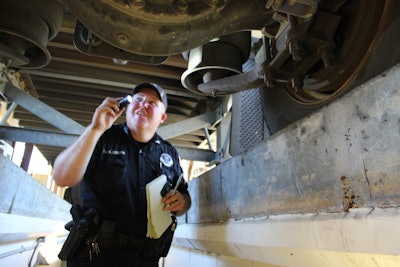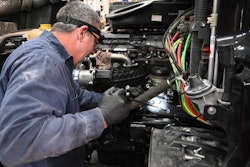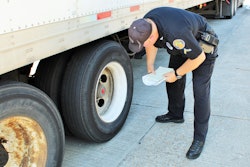 Florida Highway Patrol’s Bobby Simmons checks a truck’s steering and suspension components during a recent inspection at the Sneads weigh station off of I-10.
Florida Highway Patrol’s Bobby Simmons checks a truck’s steering and suspension components during a recent inspection at the Sneads weigh station off of I-10.In the annual 72-hour nationwide inspection blitz slated for next week, enforcers will key in on suspension and steering components, in addition to performing full Level I inspections on tens of thousands of trucks and buses.
In preparation for the annual Roadcheck inspection spree, Overdrive contributor Tom Quimby took to the scale houses and the phones to learn first hand what steps drivers can take to keep their equipment in check and avoid one of the thousands of out-of-service citations likely to be issued next week. Here’s a round-up of input from Quimby’s reporting:
Hundreds of trucks are placed out of service due to suspension violations each year during Roadcheck.
“Most of the time it’s going to be the leaf springs,” says Florida Highway Patrol Trooper Bobby Simmons, a former mechanic who’s inspected thousands of trucks over the past ten years. “I’ve seen a lot of them crack between the U-bolts and then saw one about two weeks ago that was actually broken up here (about six inches forward of the steer axle).”
Matt Copot, vice president of maintenance at Transervice, says the constant load and constant impact on leaf springs makes them a top priority for maintenance which includes looking out for loose U-bolts, damaged bottom rails and corroded spring hangars.
“You can experience cracked springs or even shifted springs and this will cause significant drivability issues with the tractor,” says Copot.
In addition to leaf spring components, Penske’s 24/7 Roadside Assistance senior manager Rowland George says to also look for air suspension leaks, worn air bags, torque rod arm bushing wear, worn spring shackle/spring eye bushings and “make sure air lines properly secured, to ensure that they aren’t rubbing on anything.”
During a truck inspection at the Sneads weigh station on I-10 Simmons points out how protective loom moved on a truck’s air line and left it vulnerable to wear as it rubbed up against the axle.
“The biggest thing that we see on air lines is going to be chafing,” Simmons explains as he points out a flat, shiny area on the black rubber hose.
Excessively worn lines can warrant an OOS violation. The rubber on this particular hose is not yet worn away enough to reveal the nylon webbing beneath so there’ll be no violation.
Following the roughly hour-long Level 1 inspection, Simmons goes over the vehicle report with the driver and tells him about the chafing. He says the truck’s air springs were fine but that’s not the case for every rig.
“They’re rubber. They wear. Over time you’ll get a small, pinhole leak,” Simmons says.
Besides checking lines and fittings for air leaks, Stemco’s suspension director David Brinkman recommends taking a closer look at the air spring itself.
“Check clearance around the air spring to allow for one-and-a-half inches for the increased diameter of the air spring in heavy jounce condition,” Brinkman says. “Check around the rubber flex member for irregular wear or material build-up.”
Simmons, during a recent inspection of a Freightliner at the Sneads weigh station on I-10 in Florida, walked through an inspection of steering and suspension components. He grabbed steering tie rods and checked for a tight fit. He inspected tie rod bolts, steering arm ball joints, drag link and cotter pins.
Given all the moving parts in a steering system, such as U-joints, gear box, Pitman arm, and tie rods, the key is knowing tolerances for movement.
“Occasionally, you will find a loose steering gear box or Pitman arm,” says Simmons who’s been inspecting trucks for the past 10 years. “You can have movement in it – rotational movement, which is normal. But if you have any vertical movement, more than 1/8th of an inch, it’s going to be an out of service.”
The inspection also took him topside, where he checked under the truck’s hood to examine steering components and check for fluid leaks.
“Driver, I need you to rock your steering wheel back and forth. Little bit more. Little more force,” he says while looking over the steering shaft and U-joints that slowly twist back and forth.
During steering inspections, Simmons feels for loose ball joints, tie rods and U-joints.
“A lot of times you can put your hand on here (on top of the steer tire) and if you’ve got something that’s loose, you’re going to feel it through this tire,” he says before flashing his light back to the network of moving parts.
“We’re looking for any movement where the output shaft connects to the Pitman arm,” Simmons continues. “That’s tight. No jumping around in the ball joints. They’re tight. Same back here. And then we look down and see that the tie rod ends and ball joints are good.”
“Excessive steering wheel play typically indicates that one or a combination of steering components is loose,” says Homer Hogg, technical development manager for the TA Truck Service and Petro Lube Truck Service. Loose components, such as steering shaft joints or splines, pitman arm, tie rod and drag link joints can all cause excessive steering wheel play. Operating a vehicle with excessive steering wheel play can result in a total loss of steering control while the vehicle is in motion. Drivers who suspect or notice excessive steering wheel play should not operate the vehicle until the root cause of the problem is determined and corrected.”








